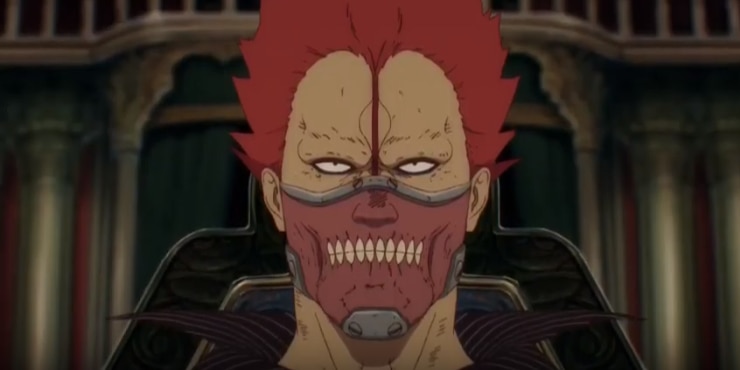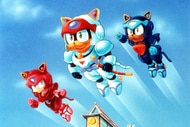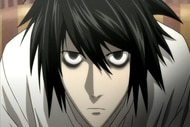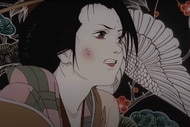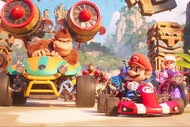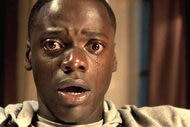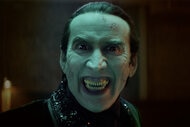Why is everyone sleeping on Dorohedoro, Netflix's wildest, nostalgia-tinged new anime?

If you’re stuck inside and looking for something new to stream — something that will break up the monotony of quarantine — you could do worse than the post-apocalyptic adventures of an amnesiac man with a lizard head. In fact, Dorohedoro, Netflix's new anime, is a quirky delight that might just be 2020’s best anime.
Based on the early '00s manga of the same name, Dorohedoro recounts the adventures of Caiman, our lizard-headed amnesiac. The story takes place in a post-apocalyptic world with a sprawling, dismal cityscape and an iconoclast aesthetic reminiscent of the punk subculture. Caiman works part-time at a hospital while moonlighting as his own private investigator. With the aid of his friend Nikaido, he goes on a quest to find the sorcerer who cursed him. Together the two get up to all sorts of bizarre activities that take the narrative on a juiced-up rollercoaster ride from the very first episode. The pacing, impenitent gore, and sheer absurdity of the world they inhabit are a wonder, highlighted by the series’ attention to detail and singular, muted color schemes.
Fans of the manga already know what they’re getting into, but even they will be wowed by Dorohedoro’s lush painted backgrounds, the uniqueness in the character detail, and especially the fluidity of the CGI animation style. In fact, the use of the hybrid animation technique is so seamlessly done, you’re not likely to realize just how wondrous it is until you’ve already fallen in love with the anime. MAPPA studio uses a special combination of two- and three-dimensional animation to produce hybrid effects in Dorohedoro. Dating back as far as 1983 to John Lassiter’s Where the Wild Things Are, the hybrid style is by no means new, and Berserk and Beastar are perhaps the most common contemporary examples of the style. However, MAPPA’s adaptation of the manga’s original gritty, detailed, 2D art style hides the use of the 3D style that gives it its fluidity. So really, if you don’t know what you’re looking at, you’ll spend half the time trying to figure out if it’s 2D or 3D, and the other half being stunned by Caiman’s crazy adventures.
The character designs are unique, edgy, and detailed, but when combined with the muted tones that dominate Dorehedoro’s color schemes, they complete the future punk aesthetic. More specifically, it’s an aesthetic that triggers a special nostalgia for the 2000s anime era that followed the '90s golden age, evoking that “end of an era dread” that inspired many anime and manga creators to imagine what a future would look like. This heritage is reflected in the dismal landscapes and the fashion choices of the characters, from the functionality in Nikaido’s pastel green overalls to the prominence of Noi's royal purple tracksuit, or the strangeness of En’s cape when draped over his formal suit.
The dismal, painted landscapes are elaborate and visually stunning, but in many ways resemble a strange fusion between the style evident in late '90s anime like The Big O, and the color palettes frequented by Studio Ghibli. The Big O coincidentally took place in a dismal post-apocalyptic world not too different from that of the "The Hole" in Dorohedoro. Many famous early '00s anime like Akira or Trigun forced viewers to contemplate the possibility of dismal new worlds and a dire future. Dorehedoro’s does this too, but by sheer coincidence, the coronavirus pandemic makes the new anime feel even more relevant. (It was released in Japan in January, but hit Netflix U.S. on May 28.) The character’s dystopian attire and bizarre masks that sorcerers wear are strangely, perhaps uneasily, relatable.
The anime’s pacing is very complex and leaves the audience feeling tugged here, there, and everywhere before even coming close to making sense of what’s going on or why. At first, Dorohedoro is intentionally elusive. It’s glorious chaos and nothing significant is happening — or at least, that’s what the show initially wants viewers to think. Yet somehow, in the height of all the madness, if one pays keen enough attention, they’re rewarded with hidden answers. From the very first episode we are thrown into a high adrenaline altercation involving Caiman and Nikaido who are battling two sorcerers, and what ensues is an unexpected bloodbath. These heart-racing scenes are accented by slow, warm moments of intimacy between characters that give a brief look at their inner human life. This expert handling of contrasting elements, speaks to a masterful understanding of dramatic and comedic timing that we come to expect from critically acclaimed films.
Both mad and methodical in how it switches points of view between the protagonist, antagonist, and even side characters, Dorohedoro achieves a grand telling that is reminiscent of live theater. This clever manipulation of POVs, merged with the contrast in pacing creates a kind of boosted narrative drive intended to keep viewers clicking onto the next episode when first watching this masterpiece. If you are resistant to weirdness, or if you have a weirdness quota, this anime is meant to break that and beat you into submission through sheer force. When you get to that state of submission, a revelation will hit you; everything is part of an elaborate narrative experience.
Beneath the varied layers of Dorohedoro is a rich narrative tapestry meant to fulfill the ages-old functions of mythology. According to literary professor Joseph Campbell, mythology exists as a means of initiating the awakening mind of the child to the mysteries of the adult world, and also as a way to represent, or discuss those things which are beyond the realm of understanding and communication. There are experiences that go beyond words, events that can only be conveyed through story and symbols. Dorohedoro’s story is heavily symbolic, especially when it comes to death and reincarnation.
The series begins with the reveal that sorcerers can survive a great number of things — including death itself. At times, this ability to make death a temporary inconvenience adds to the comical, gonzo nature of the show. Sorcerers participate in a murderous event much like The Purge called "Blue Night," but because they’ve already conquered death, it feels a bit more whimsical. It’s a common trope in many myths across the world; Odin hung himself from the world tree and rose again in nine days, Hercules jumped into the River Styx and emerged divine, Jesus rose from the dead after three days. The symbology is heaviest in the sorcerers’ world, which is presented as a kind of paradise where the magicians who have conquered things they fear the most like death and time as can be seen with En, one of the most powerful wizards in the world of magicians, and his obsessive quest for the rare life-giving and time manipulation sorcerers.
In the world of the sorcerer, control over anything as inevitable as death is merely a symbol of power that En wishes to possess in order to distinguish himself. Even injury and harm are treated with no particular seriousness. It’s a fantastic world with its own laws and fantasy has always been a place where the human mind goes to simulate conquering fear.
Dorohedoro also critiques the idea of utopia through this distinction between the world of the sorcerers and the hole. Gradually, the series reveals connections between the two worlds and in doing so shows how things in one world being great can cause things in another to become worse. It’s a conversation that the show begins to have very early that carries to the end of the season.
Dorohedoro’s life on Netflix’s streaming library is just beginning. It has the potential to come from behind as a spring release, and dominate the remainder of 2020. Considering its special quirks like visual uniqueness, use of hybrid animation, pacing, and depth of the narrative, this anime has what it takes to be great. The current kings of shonen like Demon Slayer, Black Clover, or Seven Deadly Sins should be aware that Dorohedoro has entered the chat.

